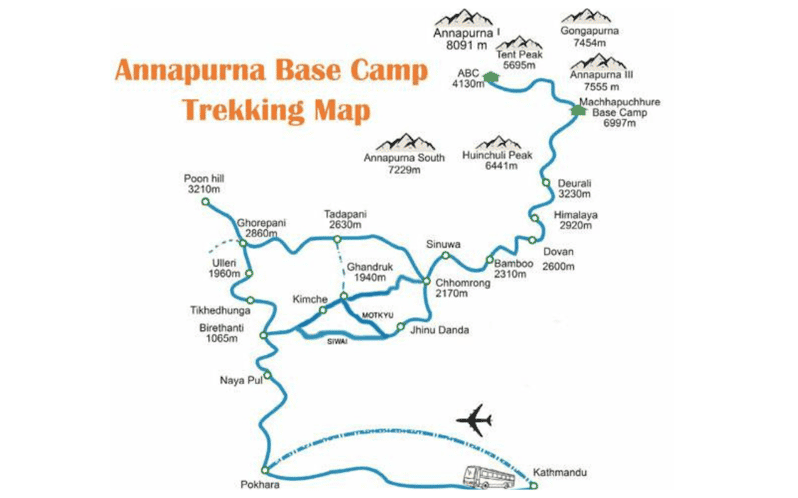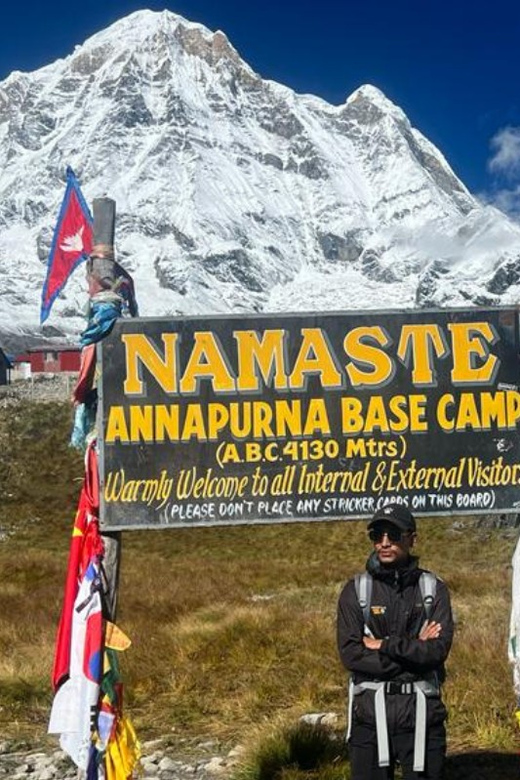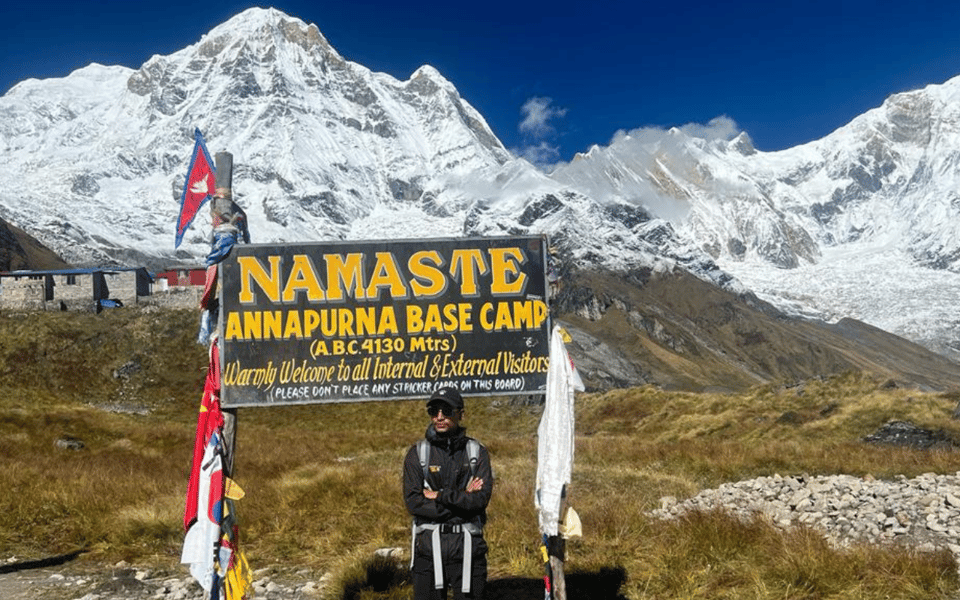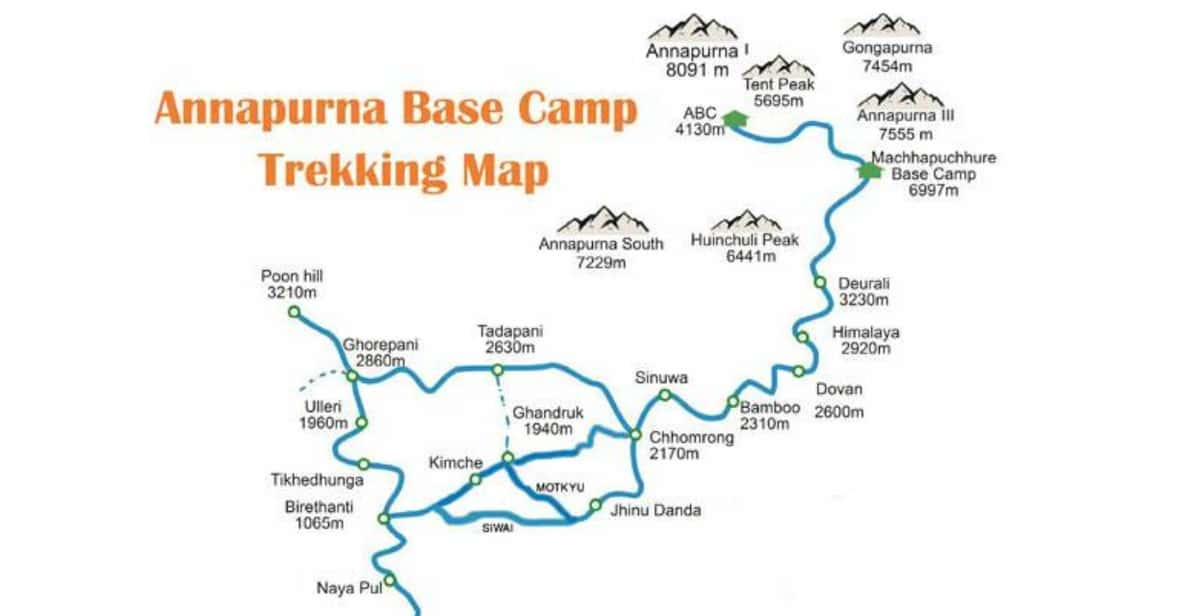When it comes to the Annapurna Base Camp trek, it’s all about the journey, not just the destination. This 8-day adventure takes trekkers through some jaw-dropping landscapes and vibrant local cultures, starting with a flight to Pokhara. The trek offers moderate challenges, making it accessible for those with decent fitness levels. With guided treks ensuring safety and comfort, it’s a well-rounded experience. But what should trekkers pack, and what local gems might they miss? The answers could change the way they approach this unforgettable trek.
Key Points

- The Annapurna Base Camp trek typically lasts 7 to 12 days, with an 8-day option being popular among trekkers.
- Starting from Kathmandu, the trek includes a flight to Pokhara and a drive to Nayapool.
- Key highlights of the trek include breathtaking views of Annapurna South, Machhapuchhre, and Gangapurna.
- Full board meals are provided during the trek, along with accommodation and necessary permits included in the package.
- Trekkers should prepare for moderate difficulty, requiring good physical fitness and proper acclimatization to avoid altitude sickness.
It's also worth checking out some other tours and experiences nearby.
Trek Overview and Itinerary

The Annapurna Base Camp trek offers adventurers an unforgettable journey through stunning landscapes and vibrant villages, typically taking 7 to 12 days to complete, depending on your chosen route and pace.
Starting in Kathmandu, trekkers hop on a flight to Pokhara before driving to Nayapool, where the real adventure begins. Along the way, they’ll pass through charming villages, lush forests, and terraced fields.
Highlights include breathtaking views of Annapurna South, Hiunchuli, Gangapurna, and the iconic Machhapuchhre. The trek covers key stops like Ghadurk Village, Sinuwa, and Deurali Dada, leading up to Annapurna Base Camp at 4,130 meters.
It’s a well-structured itinerary that balances adventure with the opportunity to soak in the local culture and landscapes.
Trekking Experience and Difficulty

Trekking to Annapurna Base Camp is a moderate challenge, perfect for those in good shape and ready for an adventure. This trek offers a mix of exhilarating trails and breathtaking views, making it a memorable experience for trekkers.
Here are a few things to keep in mind:
-
Physical fitness is key—prep your body for uphill climbs and long days.
-
Altitude sickness can be a concern; acclimatization is crucial.
-
Guided treks are recommended to navigate tricky sections safely.
-
Stunning scenery awaits, with views of majestic peaks and diverse landscapes.
-
Cultural encounters enrich the journey, as trekkers meet warm, local communities.
Included Services and Logistics

Enjoying a well-organized trek, participants can expect a range of included services that enhance their Annapurna Base Camp experience. From comfortable accommodations to expert guidance, everything’s designed for a seamless adventure.
| Included Services | Details |
|---|---|
| Accommodation | 2 nights in a 3-star hotel in Kathmandu |
| Meals | Full board meals during the trek |
| Transportation | Tourist bus from Kathmandu to Pokhara and back |
| Guides & Porters | Experienced guide and one porter per two trekkers |
With all necessary permits, airport transfers, and travel arrangements covered, trekkers can focus on soaking in the stunning views and local culture without a hitch. No hidden costs here, just pure trekking joy!
What to Bring and Tips
Packing smart is key for a successful Annapurna Base Camp trek, so trekkers should make sure to bring the right gear and essentials. The right equipment can make all the difference in comfort and enjoyment on the trail.
Here’s a quick list of must-haves:
-
Comfortable shoes: Sturdy hiking boots with good grip.
-
Layered clothing: Quick-dry shirts, thermal layers, and a waterproof jacket.
-
Sleeping bag: Choose one rated for cold temperatures.
-
Down jacket: Essential for warmth at higher altitudes.
-
Personal trekking gear: Trekking poles, hats, and sunscreen.
Plus, it’s a good idea to bring some cash for tips and personal expenses.
With the right gear, trekkers can focus on the stunning views and unforgettable experiences!
Booking and Cancellation Policy
When it comes to booking your Annapurna Base Camp trek, you’ll find flexible options that make the process smooth and stress-free.
Most companies offer free cancellation up to 24 hours in advance for a full refund, so you won’t have to worry if plans change.
Plus, there’s a handy “reserve now, pay later” option that lets you secure your spot without an immediate payment. This way, you can lock in your adventure while keeping your budget flexible.
Just remember to check availability for participants and dates before booking.
It’s all about making your trekking experience as enjoyable as possible, right? So go ahead, plan your trek with confidence!
Popular Trekking Routes
After securing a spot for the Annapurna Base Camp trek, trekkers can explore a variety of popular routes that showcase the stunning landscapes and vibrant culture of the region. Each route offers unique experiences, from charming villages to awe-inspiring mountain views.
Here are some popular options to consider:
-
Ghorepani Poon Hill: Perfect for sunrise views and a taste of local culture.
-
Jomsom Muktinath: Combines stunning desert landscapes with rich religious significance.
-
Ghandruk: A cultural gem with traditional Gurung villages and panoramic views.
-
Khopra Ridge: Less crowded, offering breathtaking vistas of the Annapurna range.
-
Annapurna Circuit: A longer trek that circles the entire Annapurna massif, showcasing diverse ecosystems.
These routes cater to various preferences and fitness levels, ensuring an unforgettable adventure!
Health and Safety Considerations
Health and safety play a crucial role in ensuring a smooth and enjoyable experience on the Annapurna Base Camp trek. Trekkers should be aware of altitude sickness, stay hydrated, and acclimatize properly. Following guidelines can help prevent mishaps and keep everyone safe on the trail.
Here’s a quick reference table for health and safety tips:
| Tip | Description | Importance |
|---|---|---|
| Stay Hydrated | Drink plenty of water throughout the trek. | Prevents altitude sickness. |
| Acclimatize | Spend extra time at higher altitudes. | Helps body adjust to elevation. |
| Stretch Regularly | Do light stretches during breaks. | Reduces muscle strain. |
| Pack a First Aid Kit | Include essentials like pain relievers. | Prepared for minor injuries. |
| Know Emergency Contacts | Keep a list of local emergency numbers. | Quick response if needed. |
Keeping these tips in mind makes the trek safer and more enjoyable!
Local Culture and Attractions
While trekking to Annapurna Base Camp, travelers get a chance to enjoy the rich local culture and experience the unique attractions that the region has to offer.
They’ll find that the journey is as rewarding as the destination. Here are some highlights worth checking out:
-
Traditional Gurung and Magar villages, showcasing local architecture and hospitality.
-
Breathtaking views of stunning peaks, including the iconic Machhapuchhre.
-
Vibrant local festivals, offering insights into Nepalese traditions.
-
Delicious local cuisine, like Dal Bhat and momos, that fuels the trek.
-
Scenic terraced fields that highlight the region’s agricultural heritage.
This trek isn’t just about the mountains; it’s about connecting with the culture and people that make this place special!
Here's a few more nearby tours and experiences we think you'll like.
Frequently Asked Questions
What Is the Best Time to Trek to Annapurna Base Camp?
The best time to trek is during spring (March to May) and autumn (September to November). During these months, the weather’s mild, the skies are clear, and the stunning views are simply unbeatable.
Are There Age Restrictions for Participants on the Trek?
There aren’t strict age restrictions for the trek, but participants should be physically fit. Generally, those between 12 and 65 find it manageable, while younger or older trekkers might need extra considerations.
How Can I Prepare Physically for the Trek?
To prepare physically for the trek, he should focus on cardiovascular exercises, strength training, and hiking practice. Regularly walking or hiking uphill will boost his stamina and help him adjust to the altitude better.
What Wildlife Can I Expect to See During the Trek?
During the trek, adventurers can spot diverse wildlife, including Himalayan tahr, langurs, and various bird species. They’ll likely enjoy glimpses of stunning flora and fauna, adding excitement to their trekking experience through the breathtaking landscapes.
Are There Internet and Mobile Connectivity Options Along the Route?
Along the trek, there’re limited internet and mobile connectivity options. In some villages, Wi-Fi’s available, but it can be spotty. Most trekkers recommend disconnecting and enjoying the breathtaking scenery instead—it’s totally worth it!
Not for you? Here's more of our most recent tour reviews happening neaby
- Kathmandu: Manaslu Circuit Trek 17 Nights 18 Days
- Nepal: Tour From Kathmandu,Pokhara,Chitwan and Lumbini
- Nepal Spiritual Yoga Tour- a Tour to Heal Your Mind and Body
- Nar Phu Valley Trek
- Kathmandu-Pokhara-Ghandruk-Chitwan Tour:10night/11Days Tour.
- Family Lower Solukhumbu Cultural Trail Trek
- 11 Days Langtang Valley Trek – a Trek to the Scenic Valley
- Gokyo Lakes: a Trek for Nature Lovers With Guided Tour
- Discover World Heritage Site and Chitwan National Park Tour
- Annapurna Base Camp Heli Tour: Kathmandu
- 10 Days Everest Base Camp Trek: Short EBC Trek Cost
- Manaslu Circuit Trek
- Everest Base Camp Heli Tour: Kathmandu
- Kathmandu: Everest Helicopter Tour With Guaranteed Landing
- Everest Base Camp Trek 13 Days
Recap
In the end, the Annapurna Base Camp trek is more than just a physical journey—it’s a chance to soak in stunning views and connect with vibrant local culture.
With the right preparation and a sense of adventure, trekkers will find themselves mesmerized by the natural beauty and warmth of the communities they encounter.
So, lace up those boots, grab your gear, and get ready to create unforgettable memories in the heart of the Himalayas!
